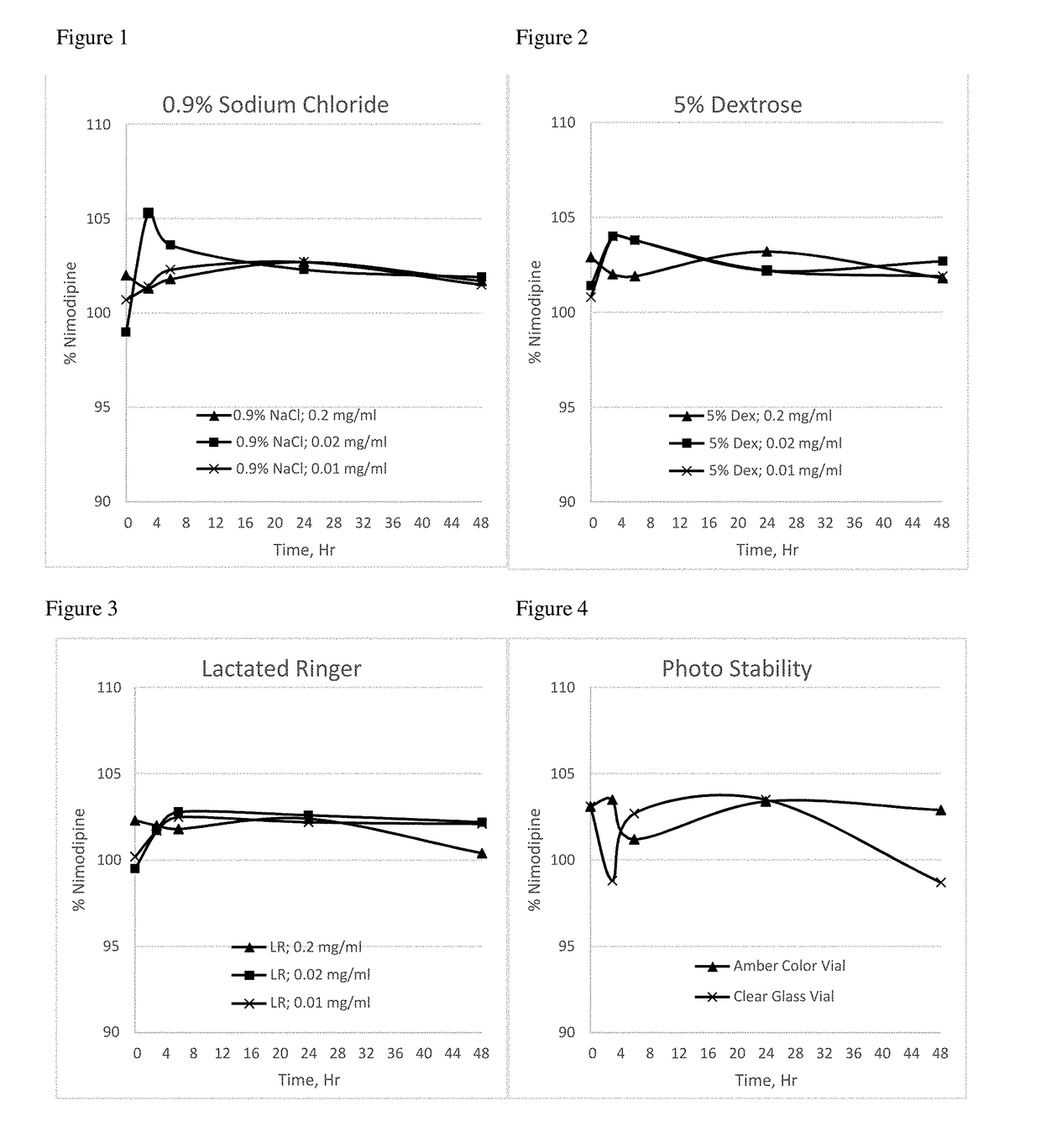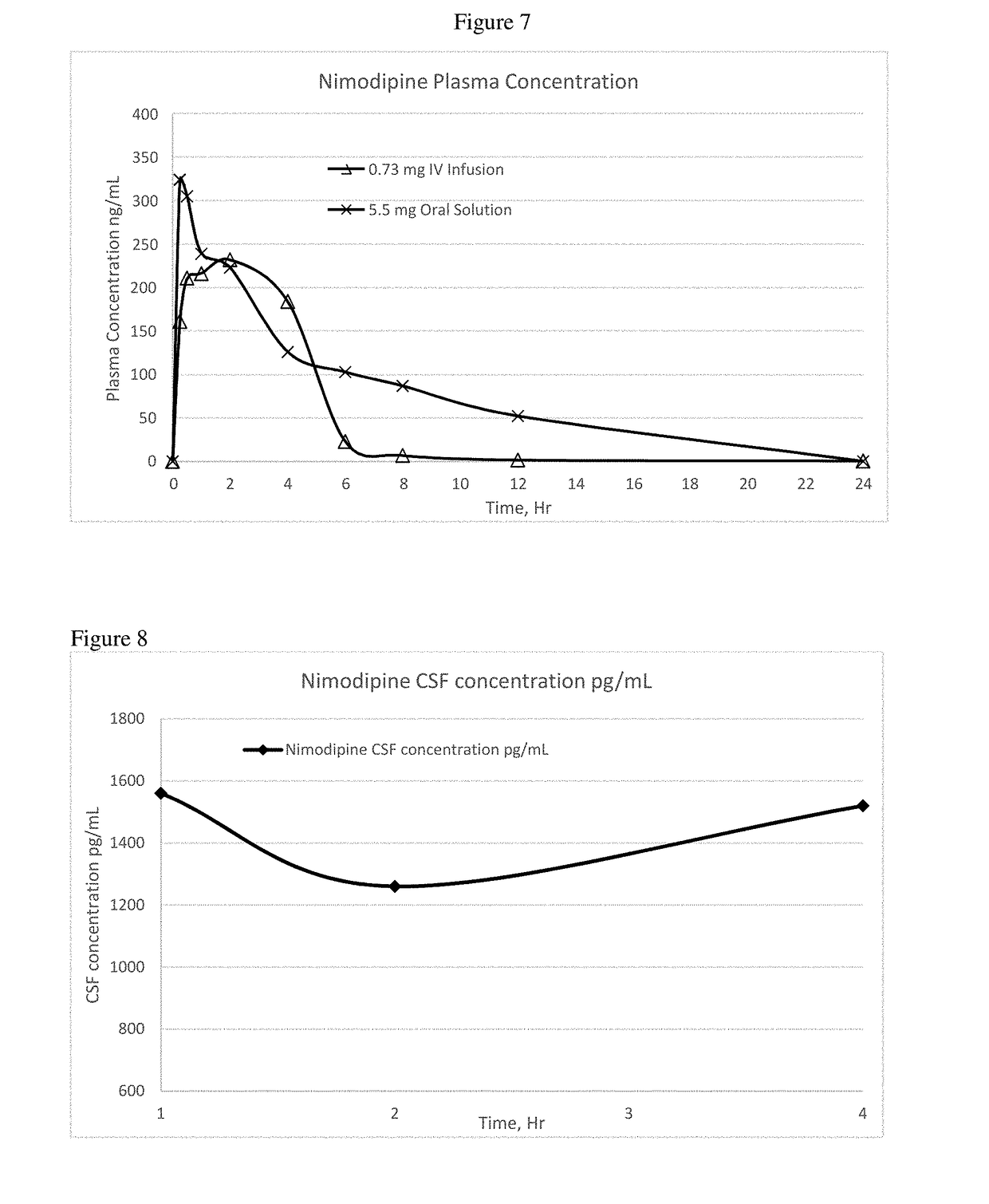Stable nimodipine parenteral formulation
a parenteral formulation and stable technology, applied in the direction of organic active ingredients, oil/fat/waxes non-active ingredients, organic active ingredients, etc., can solve the problems of significant under-dosage of nimodipine, increased risk of medication being inadvertently administered intravenously instead of by mouth or nasogastric tube, etc., to solve solubility deficiencies and stable
- Summary
- Abstract
- Description
- Claims
- Application Information
AI Technical Summary
Benefits of technology
Problems solved by technology
Method used
Image
Examples
examples 1-4
[0097]The formulation of Examples 1-4 were prepared as follows: nimodipine was added to ethanol while stirring and mixing until a clear solution is observed. Polysorbate 80 was then added as a surfactant while stirring and mixing for 30 minutes to form stable micelles. The volume was then increased to 5 ml with water for injection to prepare nimodipine injection concentrate formulations. The nimodipine injection concentrates can be diluted with any quantity of commonly used intravenous infusion solutions. The ingredients of Examples 1-4 are set forth in Table 1 below:
TABLE 1Quantity in mgCompositionEx. 1Ex. 2Ex. 3Ex. 4Concentrated Injection SolutionNimodipine10101010Ethanol 95%50010002000250Polysorbate 80400400400300Water for injectionqs 5 mlqs 5 mlqs 5 mlqs 5 mlDilution (Continuous Intravenous Infusion Solution and or water for injection)Nimodipine Concentrate 5 ml 5 ml 5 ml 5 mlInfusion solution250 ml250 ml100 ml250 ml
example 5
[0098]The nimodipine formulation of Example 3 was tested in dilution studies performed with different commonly used intravenous infusion solutions (0.9% sodium chloride, 5% dextrose, and Lactated Ringer's solution) to understand the chemical interaction and to observe if nimodipine crystals precipitate after dilution. Nimodipine crystal precipitation was not observed following dilution of this formulation with these three different IV infusion solutions, as indicated in the Table 2 below.
TABLE 2NimodipineInfusionDilutionConc,Nimodipine Assay, %solutionratiomg / mlInitial3 hour6 hour24 hour48 HourObservation0.9%5 ml in 0.2 mg / ml102.0101.3101.8102.7101.7NoSodium50 mlprecipitationChlorideobserved5 ml in0.02 mg / ml99.0105.3103.6102.3101.9No500 mlprecipitationobserved5 ml in0.01 mg / ml100.7101.4102.3102.7101.5No1000 mlprecipitationobserved5%5 ml in 0.2 mg / ml102.9102.0101.9103.2101.8NoDextrose50 mlprecipitationobserved5 ml in0.02 mg / ml101.4104.0102.2102.8102.7No500 mlprecipitationobserved5 ml...
examples 9-11
[0105]In Examples 9-11, a nimodipine concentrate is prepared as follows: Add nimodipine to polysorbate 80 and soybean oil while stirring and mix till clear solution is observed and Phospholipid Lipoid 80 and PEG 400 as emulsifiers to make a nano-emulsion and / or self emulsifying formulation. This nimodipine injection concentrate can be diluted with any quantity of commonly used intravenous infusion solution to form nano-emulsions. The formulations of Examples 9-11 are set forth in more detail in Table 5 below:
TABLE 5Quantity in mgCompositionEx. 9Ex. 10Ex. 11Concentrated Injection SolutionNimodipine101010Polysorbate 8060017252600Soybean Oil50850990Phospholipid Lipoid 8012.5PEG 40024151400Dilution (Continuous Intravenous Infusion Solution)Nimodipine Concentrate672.5 mg 5 gm 5 gmInfusion solution 50 ml50 ml50 ml
PUM
 Login to View More
Login to View More Abstract
Description
Claims
Application Information
 Login to View More
Login to View More - R&D
- Intellectual Property
- Life Sciences
- Materials
- Tech Scout
- Unparalleled Data Quality
- Higher Quality Content
- 60% Fewer Hallucinations
Browse by: Latest US Patents, China's latest patents, Technical Efficacy Thesaurus, Application Domain, Technology Topic, Popular Technical Reports.
© 2025 PatSnap. All rights reserved.Legal|Privacy policy|Modern Slavery Act Transparency Statement|Sitemap|About US| Contact US: help@patsnap.com



